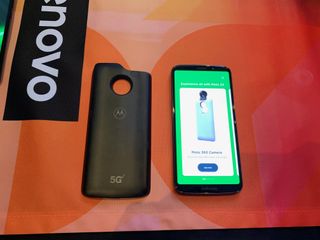Motorola targets mid-range in 5G and foldable smartphone era
"New dawn" beckons for Motorola in the mobile market

Five years on from being acquired by Lenovo, Motorola believes it is well-placed to benefit from changing trends in the mobile market.
Lenovo hoped the combination of its own mobile business with that of Motorola would catapult it to near the top of the smartphone market, challenging the likes of Samsung and Apple.
However, integration proved tricky and Lenovo was leapfrogged by other Chinese companies like Oppo and Vivo, with Huawei establishing itself as the number three player. In a market characterised by saturation and decreasing brand loyalty, Lenovo’s initial ambitions were looking farfetched.
According to recent figures from IHS Markit, Motorola is the world's eighth largest smartphone manufacturer.
- What is 5G? Everything you need to know
- Here are the best Moto G6 phone deals
- All the best phones we saw at MWC 2019
Mid-range focus
But things have changed over the past year. Motorola has narrowed its focus to specific segments of the market and specific territories, while Lenovo believes mobile can complement its strengths in PCs and servers as well as its plans to expand into solutions.
“We have done a great job at Motorola over the past 12 months as it’s the first time we’ve recorded a profit,” Antony Barounas, GM for Motorola in Europe explained. “In Europe, this is the first time we’re saying we’ll break even since we were bought by Lenovo. This is difficult in the mobile industry.
“We’ve focused on some markets … you don’t need to win everywhere, just in some places.”
Are you a pro? Subscribe to our newsletter
Sign up to the TechRadar Pro newsletter to get all the top news, opinion, features and guidance your business needs to succeed!
A refreshed product portfolio in the form of the Moto G, Moto E and Motorola One has helped increase penetration and now the next step is to target mid-range segments while increasing the Average Selling Price (ASP) of its devices.
“Personally, I see three technology waves in the next two years. The first is the mid-segment will grow in Europe… a lot. I start to see consumers understanding they don’t need to pay €1000 for a phone.”
“With the Moto G7 that’s what we are establishing more in the European business. We must be part of this technology wave.”
Increasing the ASP by targeting consumers who want more affordable devices might seem contradictory, but Barounas says there is room to work with as the increasing cost of premium handsets causes fatigue in the market.
“We are at an ASP of $155 in Europe,” he said in response to a question from TechRadar Pro. “[The mid-range segment] goes up to $300 so that is a big gap [for the Moto G line to exploit]. We’ve also introduced the Motorola One [range] which will be $200-400. This is a new segment.
“The Motorola One will not [target] the same consumer as the [Moto] G line and this will push the ASP up.”

5G and the future
The second wave identified by Motorola is 5G – something that will hardly be a surprise to anyone who has roamed the exhibition floors of Mobile World Congress (MWC) this week.
“We are the only vendor who will introduce 5G in the next month with Verizon and we will drive 5G strongly in Europe,” said Barounas. “Every 10 years when the technology changes, we think the [dominant] companies will change.”
Motorola has released a 5G ‘mod’ for its Moto mod modular phone concept. This mod turns the Moto Z3 handset into a 5G device. While it’s technically not a proper 5G smartphone, Motorola says its engineers were able to focus solely on the 5G platform rather than the overall device.
“The Moto mod has helped us … Motorola is a Lenovo company with a strong heritage of innovation,” added Jeff Snow, who is GM for the Moto Z range. “We have a team in Chicago that has been around since 1G.
"When you talk about the range of spectrum offered for 5G, it’s more challenging than anything that’s come before [in terms of devices]. You have to be careful not compromise the consumer experience … consumers won’t adopt technology for the sake of being fast.”
“Understanding how many array modules are in a device so that you have a good signal no matter where you are.”
The return of RAZR
Finally, Barounas teased that Motorola was working on a foldable phone to challenge efforts from the likes of Samsung and Huawei. Naturally, this evokes memories of the RAZR flip phone, regarded as one of the most iconic mobile phone designs in history.
“The phones look the same [across the market],” he said. “It’s difficult to differentiate and show the consumer something different. And that’s where foldables will come in.”
“I’m not allowed to say a lot but … we can play a very strong position in the market.”
- MWC (Mobile World Congress) is the world's largest showcase for the mobile industry, stuffed full of the newest phones, tablets, wearables and more. TechRadar is reporting live from Barcelona all week to bring you the very latest from the show floor. Head to our dedicated MWC 2019 hub to see all the new releases, along with TechRadar's world-class analysis and buying advice about your next phone.
Steve McCaskill is TechRadar Pro's resident mobile industry expert, covering all aspects of the UK and global news, from operators to service providers and everything in between. He is a former editor of Silicon UK and journalist with over a decade's experience in the technology industry, writing about technology, in particular, telecoms, mobile and sports tech, sports, video games and media.
